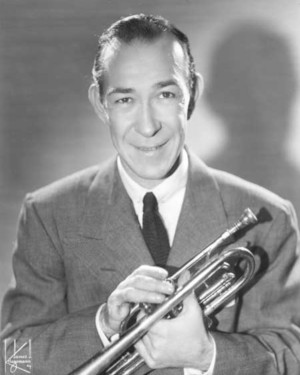Muggsy Spanier

-
Birth Name
Francis Joseph Spanier -
Born
November 9, 1901
Chicago, Illinois -
Died
February 12, 1967 (age 65)
Sausalito, California -
Featured Vocalists
Linda Keene
Ford Leary
Dottie Reid
Considered one of the greatest cornet players in history and noted for his mastery of the plunger, Muggsy Spanier began his career on the Chicago jazz scene during the late 1910s and made his first recording in 1925. He spent a number of years playing for Ted Lewis, with whose band he toured Europe and appeared on film. After leading his own seven-piece Dixieland group in the late 1930s, Spanier joined Bob Crosby’s band in May 1940, staying less than a year before announcing in January 1941 that he would form his own full orchestra.
Patterned similar to Crosby’s outfit, Spanier’s group played Dixieland-inspired swing, with a small set of musicians breaking out of the band to play pure Dixieland. Spanier had “unlimited” backing by a group of Chicago businessmen, which included his brother, and prime choice of New York musicians, who were excited at the chance to join. Before Spanier had even left Crosby and returned to New York, auditions began and a record deal was signed with Bluebird. Recording dates were set for May. Many veteran performers quit their current jobs to became part of the new orchestra, which went into rehearsals in March. Louanne Hogan was set to be its first singer.
The Bluebird recordings never happened. The orchestra went through a revolving door of personnel changes before finally settling down enough to begin performances in June. Initial reaction from the both the public and the music press was phenomenal, with many declaring Spanier’s band the best ever assembled. The group broke attendance and gate records on many occasions and was held over several times at the Arcadia Ballroom, where it seemed for a while to be a permanent fixture. They made their only recordings for Decca in mid-1942.
Spanier’s early vocalists were Dick Stone and Edythe Harper, the estranged and soon-to-be-ex-wife of Dick Haymes. When Harper left in May to return to Arkansas to finalize her divorce, Linda Keene took her place. Keene didn’t stay long, leaving in early July, and Harper returned. Harper married Spanier trombonist Vernon Brown in June and left again in September. Jeanie Ryan replaced her. By January 1942, however, Harper had returned yet again, and Jerry Scott had taken over for Stone. Harper then became pregnant and left the band for the last time in May. Dottie Reid joined as her replacement, staying only a short while. Jane Hamilton was vocalist by mid-June. Trombonist and singer Ford Leary joined the band in January 1942 and remained through at least June.
Spanier’s band, despite its great initial success, was cursed by a high turnover rate. Musicians came and went almost weekly, and by May 1942 the only original member left was trombonist Brown. Many left because they didn’t wish to tour and preferred to remain in New York. As such, the band’s quality began to suffer, and by late 1942 it had mostly vanished from the eyes of the public and the trade press. Spanier kept it going through 1943, but at some point around the first of 1944 it silently ceased to exist. Marjorie Garland was vocalist in early 1943. Spanier went back to leading small combos and briefly rejoined Ted Lewis in 1944. He continued playing his brand of Dixieland up until the time of his death in 1967 at age 65.
Sources
- Simon, George T. The Big Bands. 4th ed. New York: Schirmer, 1981.
- “Muggsy Quits; Plans New Band.” Down Beat 1 Feb. 1941: 1.
- “Muggsy Spanier To Have Own Ork Again.” Billboard 8 Feb. 1941: 9.
- “Fazola May Join the New Muggsy Band.” Down Beat 15 Feb. 1941: 1.
- “Spanier Band All Set.” Down Beat 1 Apr. 1941: 2.
- “Spanier Hires Ben Goodman.” Down Beat 15 Apr. 1941: 3.
- Hoefer Jr., George. “The Hot Box.” Down Beat 1 Jun. 1941: 16.
- Egan, Jack. “Egan Excreta.” Down Beat 15 Jun. 1941: 4.
- “Linda Keene Divorces.” Down Beat 1 Jul. 1941: 2.
- “Upheaval Hits Muggsy Spanier Band.” Down Beat 1 Oct. 1941: 2.
- “On the Stand: Muggsy Spanier.” Billboard 25 Oct. 1941: 12.
- “He Wears the Pants.” Down Beat 15 Nov 1941: 24.
- “Talent and Tunes on Music Machines.” Billboard 6 Dec. 1941: 61.
- “Spanier Ork Cuts 4 Sides With Fazola.” Down Beat 15 Jan. 1942: 2.
- “On the Air: Muggsy Spanier.” Billboard 7 Feb. 1942: 22.
- “On the Records: Muggsy Spanier.” Billboard 7 Mar. 1942: 66.
- “Orchestra Notes.” Billboard 4 Apr. 1942: 23.
- “More Changes in Spanier Band.” Down Beat 1 May 1942: 4.
- “Vaudeville Reviews: Earle, Philadelphia.” Billboard 27 Jun. 1942: 16.
- “Diggin' the Bands Where They Play: Muggsy Spanier.” Down Beat 1 Jun. 1942: 20.
- “Philly 18G Despite Heavy Competition.” Billboard 4 Jul. 1942: 17.
- “New Muggsy Chirp.” Down Beat 1 Jan. 1943: 15.
- “On the Stand: Muggsy Spanier.” Billboard 13 Mar. 1943: 22.
- “Ted Lewis Adds Muggsy Spanier.” Down Beat 15 May 1944: 1.